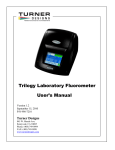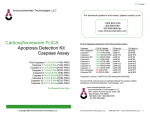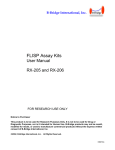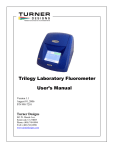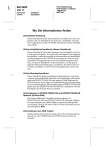Download FluorAce™ Apopain Assay Kit Fluorometric Detection of - Bio-Rad
Transcript
4100119B 5/24/99 12:28 PM Page Cvr2 FluorAce™ Apopain Assay Kit Fluorometric Detection of Apoptosis Catalog Number 170-3130 For Technical Service Call Your Local Bio-Rad Office or in the U.S. Call 1-800-4BIORAD (1-800-424-6723) Bio-Rad Laboratories, 2000 Alfred Nobel Drive, Hercules, CA 94547 4100119 Rev B 4100119B 5/24/99 12:28 PM Page i Table of Contents Section 1 Introduction ..........................................1 Section 2 Kit Contents ..........................................2 Section 3 Preparation of Stock Solutions ............3 Section 4 Experimental Procedures.....................5 4.1 4.2 4.3 AFC Calibration Curve ...................................5 Apopain Assay ................................................7 Inhibition of Apopain Activity .......................8 Section 5 Calculations...........................................9 5.1 5.2 5.3 Fluorescence Changes.....................................9 AFC Calibration Curve .................................10 Apopain Activity...........................................11 Section 6 Storage and Stability ..........................11 Section 7 Appendix .............................................12 7.1 7.2 Preparation of Cell Extracts ..........................12 Fluorometer Setting ......................................14 Section 8 References............................................17 4100119B 5/24/99 12:29 PM Page 1 Section 1 Introduction Apoptosis is defined by a cascade of biochemical events leading to nuclear fragmentation and cell death. The process is characterized by a variety of biochemical and morphological changes in the cell, including activation of proteinases, loss of membrane asymmetry, cell shrinkage, chromatin condensation, and chromosomal DNA fragmentation—currently the key marker for apoptosis. Characterization of the underlying genetic and biochemical mechanisms of apoptosis has recently become an essential part of developing methods to control apoptosis and its consequences.1 Apopain/Caspase 3 is derived from the proenzyme CPP32 at the onset of apoptosis and plays a pivotal role in programmed cell death.2–5 Among the many members of the ICE (interleukin-1 β-converting enzyme) protease family recently described throughout the literature, apopain exhibits the highest similarity to CED-3 (C. elegans cell death gene) in both sequence homology and substrate specificity.6 Apopain activity therefore appears to be a suitable indicator of critical apoptosis biochemistry. The FluorAce apopain assay kit contains all of the necessary reagents for performing a simple, continuous fluorometric assay of apopain activity. 1 4100119B 5/24/99 12:29 PM Page 2 Activity is monitored in vitro using the fluorogenic peptide substrate acetyl-Asp-Glu-Val-Asp-7-amino-4-trifluoromethyl coumarin (Ac-DEVD-AFC), a variation of the substrate described by Nicholson, et al.4 This peptidedye conjugate produces a blue fluorescence upon exposure to near-UV light. Apopain enzymatically cleaves the AFC from the peptide and releases free AFC, which then produces a blue-green fluorescence. The AFC substrate is both chromogenic (yellow-green color is visible to the naked eye) and fluorogenic (detectable at 500–550 nm with a fluorometer). Component The advantages of this assay for apoptosis are several. Apopain activity is an early marker for cells entering apoptosis. Cleavage of Ac-DEVD-AFC may be monitored fluorometrically for very sensitive and quantitative detection. The reaction enables simple kinetic analysis. The reaction is selectively inhibited by the peptide fluoromethyl ketone, Z-DEVD-FMK, a potent inhibitor of apopain. The apopain fluorogenic assay is fast, easy, quantitative, and robust. DMSO, 1.5 ml Section 2 Kit Contents The kit contains reagents for one hundred 1 ml reactions, including 20 controls with an inhibitor specific for apopain and 10 positive controls. All reactions are monitored using the fluorogenic substrate in reaction buffer. The kit also contains dye for preparing 20 calibration curves. 2 Number of Reactions Apopain substrate (Ac-DEVD-AFC, MW=729) 4 mg 100 x 1 ml Apopain inhibitor (Z-DEVD-FMK, MW=668) 0.2 mg 20 x 1 ml Apopain (dissolve in 120 µl distilled water) 10 x 1 ml 7-amino-4-trifluoromethyl coumarin (AFC) 200 µM in DMSO, 1.0 ml 25x Reaction buffer (250 mM PIPES, pH 7.4, 50 mM EDTA, 2.5% CHAPS, 125 mM DTT) (dissolve in 10 ml distilled water) 20 calibrations 250 x 1 ml Note: Measurements require a fluorometer (cuvette or microplate) using 390–400 nm excitation and 510–550 nm emission. Section 3 Preparation of Stock Solutions Prior to dissolving powders, gently tap the vial to move most of the powder to the bottom. After addition of solvent, cap the tube then invert several times to dissolve the powder. Spin briefly to bring the solution to the bottom of the vial before opening. 3 4100119B 5/24/99 12:29 PM Page 4 Apopain Substrate (Ac-DEVD-AFC) Prepare a stock solution by adding 1 ml of DMSO to a vial (4 mg) of Ac-DEVD-AFC. The concentration will be 5.5 mM. Store the stock substrate solution desiccated at 4 ˚C. Apopain Inhibitor (Z-DEVD-FMK) Prepare a stock solution by adding 200 µl of DMSO to the vial (0.2 mg) of Z-DEVD-FMK. The concentration will be 1.5 mM. Store the stock inhibitor solution desiccated at 4 ˚C. Apopain (Lyophilized Cell Extract) Dissolve the powder in 120 µl of distilled water. The vial has been overfilled to account for incomplete transfer of the solution. The vial is vacuum packed to optimize stability. Once dissolved, the solution can be transfered to a small microfuge tube for easy handling. Keep the solution on ice while preparing experiments. Store at -70 ˚C. 25x Reaction Buffer Dissolve the powder in 10 ml of distilled water. Store the solution at -20 ˚C. 4 Section 4 Experimental Procedures 4.1 AFC Calibration Curve The calibration curve can be used to quantify the AFC released from the substrate, Ac-DEVD-AFC. The calibration can be made as follows. 1. Prepare 10 ml of 1x reaction buffer, e.g., mix 400 µl reaction buffer (25x) with 9.6 ml distilled water. 2. Label seven fluorometer cuvettes, e.g., 1–7. Fill cuvette 1 with 1.95 ml reaction buffer (1x), cuvettes 2–7 with 1.0 ml reaction buffer. 3. Add 50 µl of stock AFC (200 µM) solution to cuvette 1 and measure the fluorescence (see Appendix Fluorometer Setting). Note: Adjust the fluorometer gain to obtain a signal near 50% maximum scale for this measurement, and then do not change the setting for the remainder of the experiment. Zero the fluorometer with 1x reaction buffer without AFC. 4. Remove 1.0 ml from the first cuvette and add it to 1.0 ml reaction buffer in the second cuvette, and measure the fluorescence again. Do not change the fluorometer settings. 5. Remove 1.0 ml from the second cuvette and add it to 1.0 ml reaction buffer in the third cuvette, and measure the fluorescence. 5 4100119B 5/24/99 12:29 PM Page 6 6. Repeat this process for six cuvettes. Do not transfer solution to cuvette 7. Measure cuvette 7 without dye (baseline). 7. The following table can be used as a guide for making the serial dilutions and for plotting the calibration curve (see Section 5.2, AFC Calibration Curve). Cuvette AFC 1x reaction buffer [AFC] final 1 50 µl of 200 µM stock 1.95 ml 5 µM (10 nmole) 2 1.0 ml of 5 µM (Cuvette 1) 1.0 ml 2.5 µM (5 nmole) 1.0 ml of 2.5 µM (Cuvette 2) 1.0 ml 1.25 µM (2.5 nmole) 3 4 5 6 1.0 ml of 1.25 µM (Cuvette 3) 7 6 The assay can be used with a cuvette or microplate fluorometer. See Appendix 7.2, Fluorometer Setting, for general recommendations on fluorometer conditions. Reactions may be prepared in fluorometer cuvettes using the following guide. For each set of reactions, one blank reaction should be prepared to measure substrate background and instrument drift. Blank Sample 25x Reaction Buffer 40 µl 40 µl 40 µl Ac-DEVD-AFC 10 µl 10 µl 10 µl Sample none 1–100 µl none 0.31 µM (0.63 nmole) Apopain (positive control) none none 10 µl 950 µl volume to 1,000 µl 940 µl 1.0 ml 0.15 µM (0.31 nmole) 1.0 ml Zero 1. Mix the samples, measure the fluorescence, and record the time and signal. 2. Seal the cuvettes with Parafilm and incubate at 20–37 ˚C. 3. Repeat the fluorescence readings every 30–60 minutes until the sample measurements are complete. A single time point is sufficient to determine the substrate 1.0 ml 1.0 ml of 0.31 µM (Cuvette 5) Crude cell lysates and partially purified or purified cell preparations may be assayed (see Appendix 7.1 Preparation of Cell Extracts). In addition to a blank (no enzyme), the following controls may be run to insure positive detection: a non-apoptotic cell lysate, a sample to which the inhibitor has been added (see Section 4.3, Inhibition of Apopain Activity), and a positive control (apopain). Component 1.0 ml 1.0 ml of 0.63 µM (Cuvette 4) 4.2 Apopain Assay 0.63 µM (1.25 nmole) Water 7 Positive control 4100119B 5/24/99 12:29 PM Page 8 turnover rate from the calibration curve. A large change in fluorescence within the first 30–60 minutes may indicate very high activity and subsequent measurements may be outside of the linear range of the reaction. At least two time points should be measured to check for consistent activity. Low activity may take several hours to detect. 4. The positive control (apopain cell extract) should produce a linear increase in fluorescence over 3 hours when incubated at room temperature (20 ˚C). The activity of the apopain cell extract contained in the kit is printed on the bottle label. 4.3 Inhibition of Apopain Activity To test for interference from non-specific protease activity, compare a sample with and without the apopain specific inhibitor Z-DEVD-FMK. Reactions may be prepared in fluorometer cuvettes using the following guide. Do not add the substrate until after mixing and incubation of the following mixtures. Component Blank Sample Negative control 25x Reaction Buffer 40 µl 40 µl 40 µl Z-DEVD-FMK (inhibitor) none none 10 µl Sample none 1–100 µl = same sample volume Distilled Water 950 µl volume to 990 µl volume to 990 µl 8 1. Mix the samples, seal the cuvettes with Parafilm, and incubate at 20 ˚C for 30 minutes. 2. Add 10 µl of substrate (Ac-DEVD-AFC) to each tube, mix, and measure the fluorescence immediately (t = 0). Incubate at 20–37 ˚C. 3. Repeat the fluorescence readings every 30–60 minutes until the sample measurements are complete. Activity measured for the negative control (see ∆F below) will be from enzymes other than apopain. Note: When using the positive control cell extract as a sample, inhibition should be about 95% under the conditions above. Section 5 Calculations 5.1 Fluorescence Changes 1. Calculate the increase in fluorescence over time for each sample as follows: ∆F = [Fsample(at ti) - Fsample(at t0)] - [Fblank(at ti) - Fblank (at t0)] where F = fluorescence signal as recorded from the fluorometer; ti = the reaction time; sample = cuvette containing either an experimental sample or apopain control; blank = control cuvette containing only substrate in reaction buffer, without apopain. 9 5/24/99 12:29 PM Page 10 2. Calculate enzyme activity for t i (see Section 5.3, Calculations—Apopain Activity). If activity is low, the assay should be allowed to proceed for a longer time. Data collected when more than 10% of the substrate has been consumed (e.g., 5 nmole AFC produced) may not be linear. 5.2 AFC Calibration Curve Prepare a calibration curve by plotting AFC concentration (nanomoles) vs fluorescence change (∆F)–see Section 4.1 (AFC Calibration Curve). 5.3 Apopain Activity Units apopain in sample = ∆F/minute x (calibration curve slope)-1 x 1000 where ∆F/minute x (calibration curve slope)-1 = nmoles of AFC produced/minute, ∆F is defined in Section 5.1. The factor of 1000 converts nmole AFC per minute to activity units. For example, ∆F = 700, time = 60 minutes, calibration curve slope = 2000, Units apopain in sample = (700/60) x (1/2000) x (1000) = 5.83 units 20,000 Section 5.1, Calculations—Fluorescence Changes. 15,000 ∆F 4100119B 10,000 slope = 5,000 2000 (nmole) AFC 0 0 2.5 5.0 AFC (nmole) 7.5 10 Section 6 Storage and Stability The kit is shipped at room temperature. Ac-DEVD-AFC and Z-DEVD-FMK Store at 4 ˚C, protected from moisture. These reagents are stable for 1 year from the date of purchase when stored as received and for at least 6 months when stored in DMSO. Apopain Store at 4 ˚C, protected from moisture. After being dissolved in distilled water, store frozen at -70 ˚C. Repeated freeze-thaw cycles may reduce activity slightly. This compound is stable for 1 year from the date of purchase when stored as received and at least 6 months when stored in solution at -70 ˚C. 10 11 4100119B 5/24/99 12:29 PM Page 12 Reaction Buffer Store at 4 ˚C, protected from moisture. After being dissolved in distilled water, the solution should be stored at -20 ˚C. This reagent is stable for 1 year from the date of purchase when stored as received and at least 6 months when stored in solution at -20 ˚C. AFC and DMSO These compounds are stable for 1 year from the date of purchase when stored at room temperature. Storage at 4 ˚C is acceptable (although they will freeze). Section 7 Appendix 7.1 Preparation of Cell Extracts Because of the specificity of apopain for the fluorogenic substrate, and because of the stability of the substrate, it is possible to perform this assay using a crude cell extract. Performing the assay in the presence of the inhibitor provided with the kit provides a means of confirming that the proteolytic activity is due to the activity of apopain. The following procedure is provided only as a suggestion for harvesting and lysing cells. The user will need to develop a specific procedure. For example, see Thornberry (1994). 12 • Grow ~107 cells under appropriate conditions. Suspension cultures may be grown in 75 cm2 flasks. Attached cells should be grown on 100 mm tissue culture plates. If necessary, stimulate cells to undergo apoptosis. • Suspension cultures: transfer media with cells to a 15 ml disposable centrifuge tube. Pellet cells (7–8 min at 600 x g). Remove supernatant and rinse the pellet with PBS or media without serum. Re-pellet cells and remove supernatant. Lyse the suspension culture by adding 100 µl of Apopain Lysis Buffer to the cell pellet. Vortex gently to resuspend the cell pellet then freeze and thaw the sample four or five times by transferring from an isopropanol-dry ice bath to a 37 °C water bath; do not vortex between freeze-thaw steps. • Attached cultures: harvest floating cells by transferring the media to a 15 ml disposable centrifuge tube; pellet the cells; remove the supernatant. Wash the attached cells twice with 4–5 ml of PBS or media without serum; add this to the pellet of floating cells in the 15 ml disposable centrifuge tube. Re-pellet the cells; remove the supernatant. Lyse the attached cells on the 100 mm tissue culture plate by adding 100–150 µl of Apopain Lysis Buffer and scraping the cells; transfer the buffer and cell debris to the 15 ml centrifuge tube. Freeze and thaw the sample four or five times as indicated above for suspension cultures. 13 4100119B 5/24/99 12:29 PM Page 14 • Transfer the lysed cell extract to a microfuge tube. Spin for 30 minutes at full speed in a microfuge at 4 °C to pellet the cell debris. Remove the supernatant to assay apopain activity and protein content. • Phosphate-buffered saline (PBS) 10 mM sodium phosphate, pH 7.2–7.4 150 mM NaCl Dissolve 8.8 g of NaCl, 1.2 g of Na2HPO4, and 0.22 g of NaH2PO4 in 800 ml of distilled water. Adjust the pH to 7.3 ± 0.1 with 10 N NaOH. Add water to 1 liter. Dispense the solution into bottles and autoclave for 20 minutes at 15 psi on the liquid cycle. Store at room temperature. • Apopain Lysis Buffer 10 mM HEPES, pH 7.4 2 mM EDTA 0.1% CHAPS 5 mM DTT 1 mM PMSF 10 µg/ml pepstatin A 10 µg/ml aprotinin 20 µg/ml leupeptin 7.2 Fluorometer Setting The following procedure can be used as a guide for making measurements in a cuvette or microplate fluorometer. Refer to the user manual regarding specific operating instructions for your fluorometer. 14 Select The Wavelengths Excitation = 390–400 nm, emission = 510–550 nm (fluorescein filter). Refer to the manufacturers guide for use of the fluorometer. • In a scanning fluorometer, select in the range 390–400 nm for excitation and 510–550 nm for emission, and adjust slit widths to get a good signal. See Set the Detection Scale below. • In a filter fluorometer, insert a 390–400 nm excitation filter in the excitation side and a fluorescein emission filter (or equivalent) in the emission side. Set the Detection Scale 1. Zero the detection scale using a cuvette containing 1x Reaction Buffer (cuvette 7). If using a VersaFluor™ fluorometer, first set the gain to low, and the range setting to zero. 2. Insert the most concentrated solution (5 µM AFC) made for the calibration curve into the fluorometer (cuvette 1). Adjust the instrument settings, e.g., adjust the gain to obtain a signal near 50% maximum. If using a VersaFluor fluorometer, the reading should be less than 10,000 (half maximum) given the settings in Step 1 above. 15 4100119B 5/24/99 12:29 PM Page 16 Note: After the detection scale is set, do not readjust the gain or fluorometer settings during the experiment. Measure the Fluorescence Calibration Curve • Insert each of the AFC calibration solutions and record the fluorescence signal. Section 8 References A full list of references may be obtained by calling your local Bio-Rad office. 1. Measure the Samples and Controls • Insert the blank sample and record the fluorescence signal and time. 2. • Insert the experimental sample and record the fluorescence signal and time. • Insert the control sample and record the fluorescence signal and time. 3. • Repeat the measurements at least once to check for consistency in the activity calculation (see Section 5.3–Apopain Activity) 4. 5. 6. 7. 16 Nicholson, D. W., ICE/CED3-like proteases as therapeutic targets for the control of inappropriate apoptosis, Nature Biotech., 14, 297–301 (1996). Goldberg, Y. P., Nicholson, D. W., Rasper, D. M., Kalchman, M. A., Koide, H. B., Graham, R. K., Bromm, M., KazemiEsfarjani, P., Thornberry, N. A., Vaillancourt, J. P. and Hayden, M. R., Cleavage of Huntington by apopain, a proapoptotic cysteine protease, is modulated by the polyglutamine tract, Nat. Genet., 13, 442–449 (1996). Nasir, J., Goldberg, Y. P. and Hayden, M. R., Huntington disease: new insights into the relationship between CAG expansion and disease, Hum. Mol. Genet., 5, 1431–1435 (1996). Nicholson, D. W., Ali, A., Thornberry, N. A., Vaillancourt, J. P., Ding, C. K., Gallant, M., Gareau, Y., Griffin, P. R., Labelle, M., Lazebnik, Y. A., et al., Identification and inhibition of the ICE/CED-3 protease necessary for mammalian apoptosis, Nature, 376, 37–43 (1995). Rotonda, J., Nicholson, D. W., Fazil, K. M., Gallant, M., Gareau, Y., Labelle, M., Peterson, E. P., Rasper, D. M., Ruel, R., Vaillancourt, J. P., Thornberry, N. A. and Becker, J. W., The three-dimensional structure of apopain/CPP32, a key mediator of apoptosis, Nat. Struct. Biol., 3, 619–625 (1996). Kuida, K., Zheng, T. S., Na, S., Kuan, C., Yang, D., Karasuyama, H., Rakic, P. and Flavell, R. A., Decreased apoptosis in the brain and premature lethality in CPP32deficient mice, Nature, 384, 368–372 (1996). Thornberry, N. A., Interleukin-1β converting enzyme, Methods in Enzymology, 244, 615–631 (1994). 17












